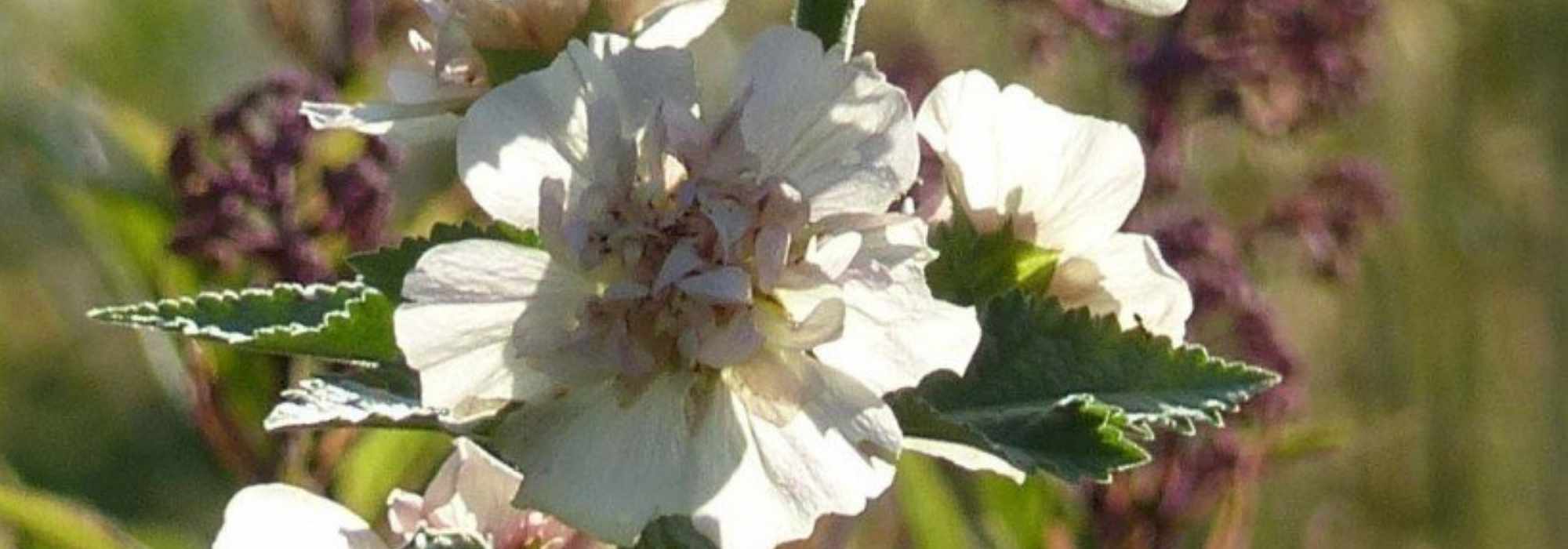
Alcalthaea : planting, pruning, maintenance
Contents
Alcalthaea in a nutshell
- It is a semi-shrubby perennial, a cross between hollyhock and hibiscus
- This hybrid has an upright shrubby habit, often exceeding 2 m in height
- All summer long and until the first frosts, it delights with its magnificent flowering in corollas resembling hibiscus flowers
- Very hardy, it grows easily in full sun in any light, well-drained soil
- Highly floriferous, it is perfect for cottage and natural gardens
A word from our expert
The (x)Alcalthaea suffrutescens is a semi-perennial bush, a cousin of the hollyhock and Hibiscus or Althaea. This hybrid plant combines the qualities of its two parents: bushy habit and floribundity. It is interesting for its upright habit, suitable for gardens of all sizes, as well as for its long flowering with delicate colours. It quickly forms a bush of 1.5 to 3 m in height and offers from June to early October, simple to semi-double flowers, ranging from pink-mauve to ivory white in the Alcalthaea ‘Parkallee’. These hibiscus-like flowers continuously renew from summer until early autumn, attracting pollinating insects.
Hardy down to -15°C, it is easy to grow in full sun and adapts to any well-drained ordinary soil, even calcareous.
Very bright and natural, it will bring colour and delicacy to your free hedges, path borders, or the back of your flower beds. Discover how to cultivate it.
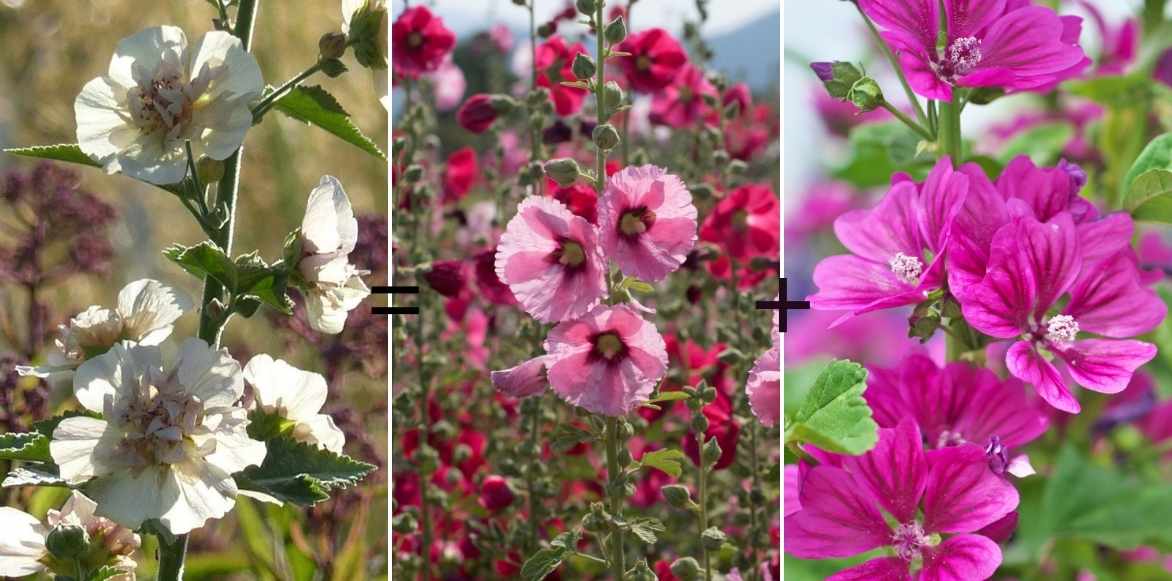 The Alcalthaea is the result of a hybridization between the hollyhock (Alcea) and the tree mallow or bush mallow.
The Alcalthaea is the result of a hybridization between the hollyhock (Alcea) and the tree mallow or bush mallow.Description and Botany
“`html
Botanical data
- Latin name Alcalthaea suffrutescens
- Family Malvaceae
- Common name Alcathaea
- Flowering June to October
- Height 2 to 5 m
- Exposure Sun
- Soil type Clay-loamy (rich and light), Stony (poor and filtering)
- Hardiness -15 °C and beyond
The Alcalthaea suffrutescens is a semi-woody perennial from the Malvaceae family, like Lavatera, hollyhocks, Mallow, and hibiscus. It is a hybrid plant resulting from the cross-breeding between hollyhocks (Alcea), a perennial, and tree mallow or Tree Mallow (Althea), a bush, which gives rise to an inter-generic species named (x) Alcalthaea. First appearing in a Hungarian garden in the 1970s, this hybridization has only been offered by French nurserymen for about ten years. Today, only a few varieties are available for sale: ‘Freedom’ with pale pink flowers fading to light garnet, ‘Parkrondell’ with pink-mauve flowers with grey reflections, and ‘Parkallee’, with semi-double flowers. They are particularly distinguished by the colour of their flowering.
The Alcalthaea forms a beautiful bushy clump with an upright habit. It reaches heights of 1.5 to 3 m, sometimes up to 5 m, with a spread of 80 cm to 1 m, and lives for 5 to 6 years. Large fuzzy stems rise from a taproot. They develop deciduous foliage reminiscent of Althea. The leaves, arranged alternately along unbranched stems, are lanceolate and more or less lobed with dentate and undulate edges. Slightly fuzzy, they are light green or ash grey. The foliage is very healthy and proves resistant to rust, a sensitivity often attributed to hollyhocks.
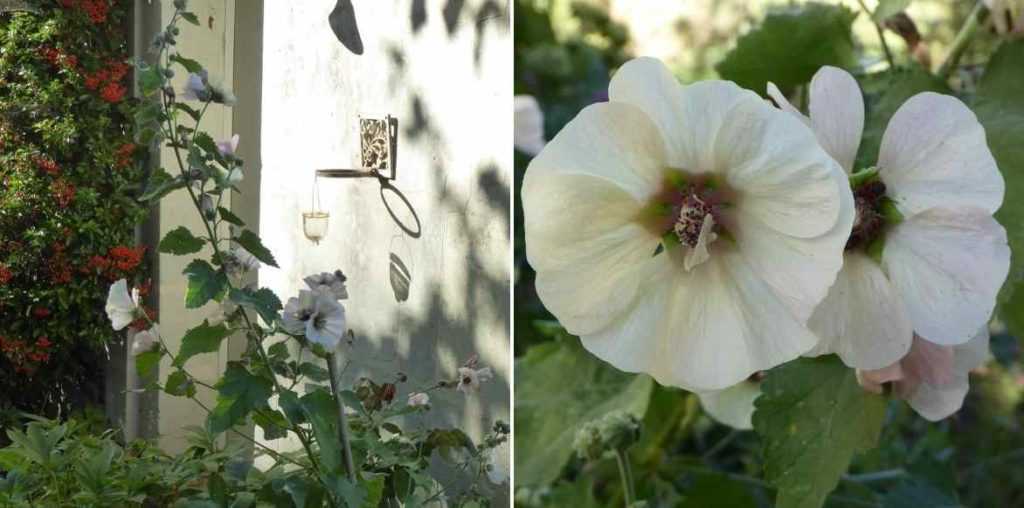
Alcalthaea Parkallee (© Gwenaëlle David)
The Alcalthaea boasts the brilliance and abundance of flowering seen in hollyhocks. From June to September, but often until the first frosts, the flowers, more numerous than those of its relatives, cascade down the hairy stems. Large flower buds open progressively from the bottom to the top. The flowering takes the form of single or semi-double corollas, similar to hibiscus flowers. They bloom in well-opened cups, 4 to 6 cm wide. Their petals are delicately crumpled.
They take on very nuanced and delicate shades depending on the varieties, even more vibrant than those of its two parents, ranging from pale pink tinged with light garnet to violet-pink with grey reflections in ‘Parkrondell’, passing through ivory white with a fawn tint tinged with apricot and a frizzy heart with raspberry stamens in Alcalthaea ‘Parkallee’. Like all Malvaceae, the flowers of the alcalthaea are edible and can be added to summer salads for a colourful touch.
Not fragrant, these delicate corollas compensate for this lack with their remarkable floribundity, renewing continuously throughout the summer until autumn. Melliferous, they attract bees, butterflies, and other pollinating insects. The alcalthaea is a valuable ally for the biodiversity of our gardens.
The flowering stems hold well in vases and make beautiful bouquets with fresh colours.
“`
Main varieties
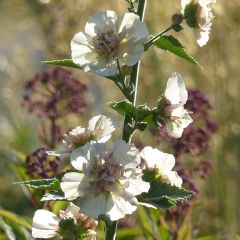
x Alcalthaea suffrutescens Parkallee
- Flowering time July to October
- Height at maturity 1,50 m
Discover other Alcea
View all →Available in 1 sizes
Available in 1 sizes
Available in 2 sizes
Planting of the alcea
Where to plant it?
Hardy down to -15°C (Zone 7b), Alcalthaea can be grown throughout France. Like all Malvaceae, it loves the sun and light soils, even poor, calcareous or stony but will flower better in rich soil. It needs well-draining soil in which it will be more long-lived as it dislikes clayey and heavy lands. It will tolerate relative summer drought in the northern regions of the Loire. It will be content with light shade in southern regions. While it can withstand occasionally dry soils, it will be more floriferous in soil that retains moisture in summer.
It is also well-equipped against the wind. Ensure a clear location which will encourage it to reach its full height.
With its always very fresh colours and simple yet elegant flowering, it is ideal for countryside and natural gardens or romantic settings. It can be used in hedges, to border a path or to fill out a mixed border, as well as in isolation or at the back of a perennial bed, or even to dress a wall. Its tall silhouette adds charm and verticality.
When to plant it?
The planting of Alcalthaea is preferably done in spring, from March to May, after the frosts.
How to plant it?
Plan for 1 plant per m². You will create a beautiful bush that flowers for a long time by planting in groups of five or seven plants. The soil should be light and well-drained. In heavy soils, it is essential to add sand and gravel (1/3) and potting soil to improve drainage.
- Dig a hole 2 to 3 times the size of the pot
- Spread gravel 5 to 10 cm deep at the bottom of the hole for good drainage
- Place the root ball at collar level
- Plant by adding potting soil to the garden soil
- Lightly firm down with your foot
- Water generously at planting and until establishment
Maintenance, pruning and care
Alcalthaea is easy to maintain when well established in well-drained soil. Water regularly but without excess, two or three times a week during the first summer following planting. Afterwards, it will tolerate a short period of drought well. You will mainly water during dry weather.
Regularly remove faded flowers to encourage further flowering.
In autumn, in very cold regions, you can apply a mulch (straw or dead leaves) to protect the stump from severe cold.
Short-lived, the plants disappear in 5 to 6 years, we recommend renewing one plant out of three each year to maintain well-filled clumps.
Unlike other Malvaceae, Alcalthaea is not subject to rust, the fungus that leaves orange pustules on the leaves.
When and how to prune Alcalthaea
Pruning is recommended as it helps stimulate growth by encouraging the development of new shoots and thus flowering.
- In March, perform a severe pruning to promote a more abundant future flowering. Using pruning shears, cut back the old wood to 80 cm above the ground to maintain a compact habit and a height not exceeding 1.50 m. Remove any excess or poorly placed stems.
- In June, you can lightly prune again by cutting back the branches to encourage them to branch out.
- Every 2-3 years, pinch the stems in May-June to maintain a compact silhouette.
Multiplication
Successfully Propagating Alcathea Cuttings
Alcathea is very easily propagated by cuttings. Proceed from April to September using current year’s shoots.
- Choose vigorous shoots
- Using a pruning shear that has been disinfected, take stems measuring 10 to 15 cm
- Remove the leaves from the base and eliminate any flowers and buds
- Insert the cuttings into buckets filled with a mixture of sand and potting soil, keeping it very slightly moist
- Place in partial shade
- Keep them under a frame throughout the winter, maintaining the substrate moist but not waterlogged
- In the following spring, transplant them to their permanent location
Associate
Alcalthaea naturally finds its place in gardens with a natural style, country gardens, and English cottage gardens. With its soft hues, it fits well in romantic borders. It is stunning at the back of borders or for covering the walls of a walled garden.
In a border of summer-flowering bushes, it will accompany the blooms of Hibiscus or Althaea, Abelia, Buddleia, or simply old roses.
In a border of summer-flowering perennials, it pairs well with large pink or blue asters or gauras, hollyhocks, and mallows, such as Salvia nemorosa ‘Amethyst’. It will benefit from being associated with more graphic blooms like the spherical heads of Allium ‘Globemaster’ or the slender stems of Verbena bonariensis.
A few clumps of grasses, the delicate Melica altissima ‘Atropurpurea’, with a slightly wild appearance, Pennisetum alopecuroides, Miscanthus, or Stipa tenuissima will bring softness to contrast with the upright habit of Alcalthaea.
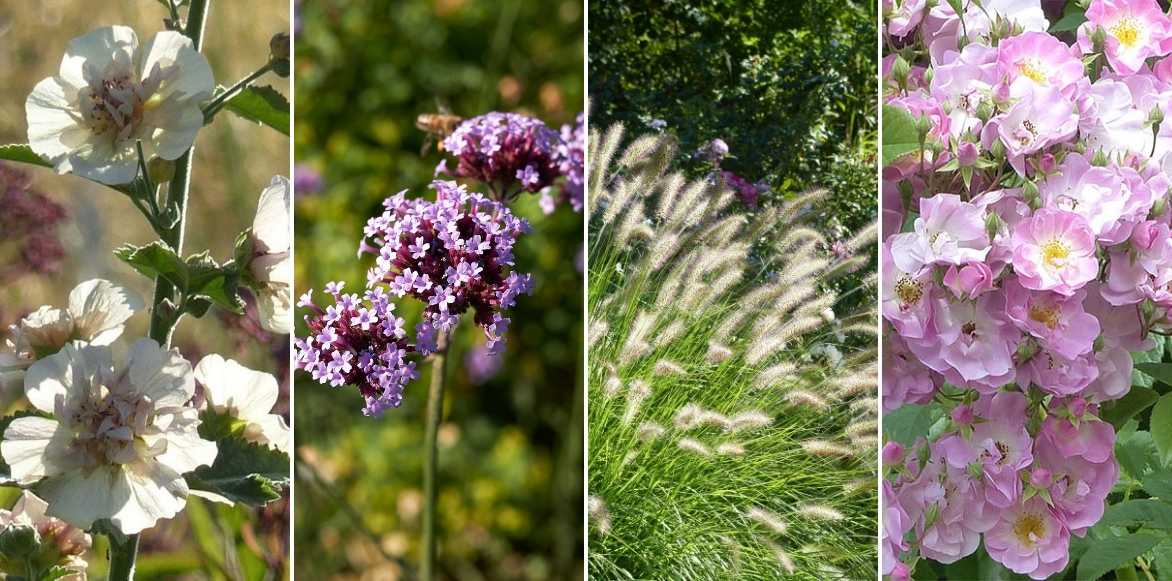 Alcalthaea ‘Parkallee’, Verbena bonariensis, Pennisetum alopecuroides ‘Hamlen’ and old rose ‘Blush Rambler’
Alcalthaea ‘Parkallee’, Verbena bonariensis, Pennisetum alopecuroides ‘Hamlen’ and old rose ‘Blush Rambler’→ Discover more inspirations and ideas for pairing Alcalthaea in our advice sheet!
Useful resources
- Draw from the large family of Malvaceae to create a mauve inspiration in the garden! Lavateras, hibiscus, hollyhocks…
- Discover our selection of 10 bushes with summer flowering that you must have in your garden
- Subscribe!
- Contents

































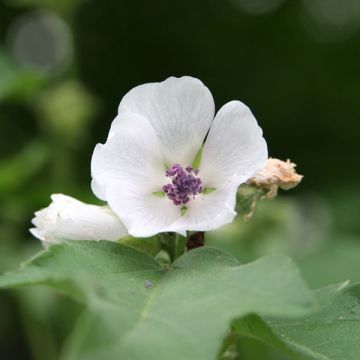
Comments